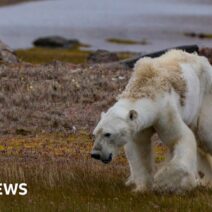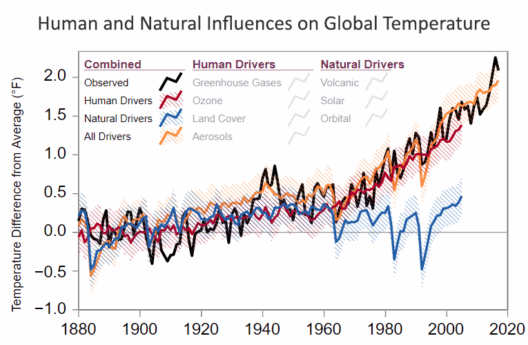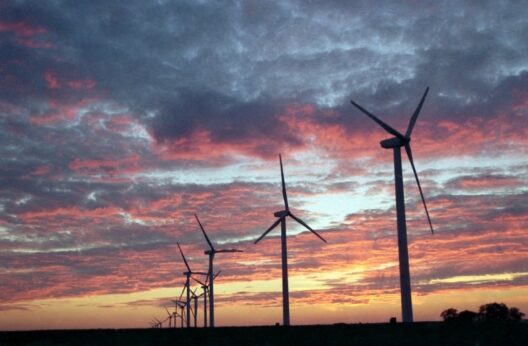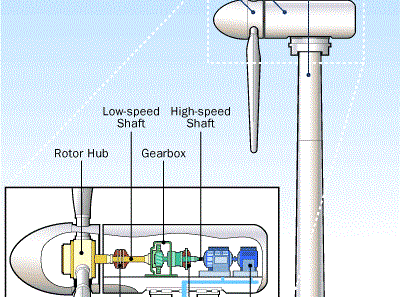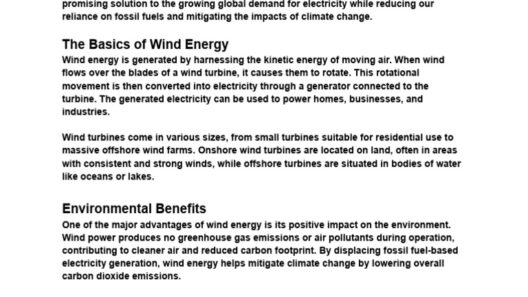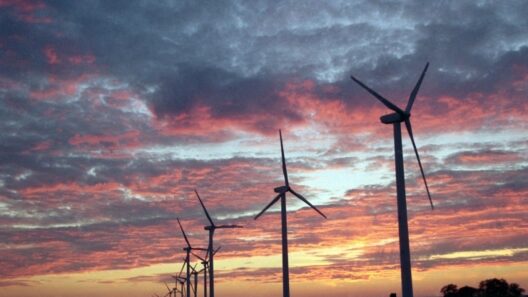Wind energy has emerged as a pivotal player in the global quest for sustainable and renewable energy sources. As societies become increasingly aware of the dire implications of fossil fuel consumption, the benefits of wind power stand out, heralding a transformative shift in energy production and consumption.
One of the most significant advantages of wind energy is its minimal environmental impact. Unlike traditional forms of energy generation, wind power harnesses the kinetic energy of moving air without depleting natural resources or emitting greenhouse gases. This renewable energy source significantly mitigates air pollution, contributing to cleaner air and reducing the public health risks associated with fossil fuel combustion.
Moreover, the installation of wind turbines has a negligible effect on the land they occupy. Turbines can be strategically placed on agricultural lands, allowing farmers to continue their work without disruption while simultaneously generating supplemental income through lease agreements with energy companies. This synergistic relationship exemplifies how wind energy can coexist with traditional land uses, creating a dual-purpose environment.
Another noteworthy benefit of wind energy is its contribution to energy security and independence. Countries that invest in wind power reduce their reliance on imported fuels, thereby safeguarding themselves against volatile energy prices and geopolitical tensions. By nurturing domestic energy sources, nations not only enhance their energy resilience but also pave the way for economic stability, as the money spent on local energy production remains within the community, fostering job creation and local growth.
In addition to economic benefits, the wind energy sector is a burgeoning source of employment. Diverse skilled and semi-skilled jobs in the manufacturing, installation, and maintenance of wind turbines have proliferated in regions committed to harnessing wind power. This job creation is particularly crucial in rural areas, where economic opportunities may be sparse. Investing in wind energy can rejuvenate local economies, enhance livelihoods, and promote workforce development through targeted training programs.
The technology surrounding wind energy has also seen remarkable advancements, enhancing the efficiency and efficacy of wind turbines. Modern turbines are equipped with sophisticated control systems that optimize their energy production based on wind conditions. This means that wind farms are not only becoming larger and more powerful but also more efficient, generating more energy with fewer turbines than ever before. As technology continues to evolve, the cost of wind energy is expected to decrease further, making it an increasingly attractive option for consumers and governments alike.
Wind energy also possesses a significant advantage when it comes to the scalability of energy projects. Wind farms can vary in size—from small community-based projects that power local homes to large-scale installations that supply energy to entire cities. This flexibility allows for tailored solutions that can meet specific regional energy demands, bridging the gap between energy supply and consumption effectively.
Equally important is the public perception of wind energy. As more individuals recognize the pressing challenges posed by climate change, the support for renewable energy sources, including wind, has grown significantly. Enhanced public awareness campaigns and educational initiatives have cultivated a greater understanding of the environmental benefits associated with wind energy, leading to increased community support for new projects. This societal shift is instrumental in the successful implementation of wind energy initiatives, as local acceptance can often dictate the fate of renewable energy projects.
However, it is essential to consider the implications of wind power beyond environmental and economic facets. Wind energy fosters community engagement and social responsibility. Many wind energy projects incorporate community involvement initiatives, offering local residents a stake in the development process. This collective investment often leads to stronger community bonds, as residents unite around a common cause—embracing renewable energy for the benefit of the environment and future generations.
On the regulatory front, government incentives and policies supporting renewable energy have propelled the growth of wind power. Tax breaks, grants, and renewable energy mandates incentivize both large-scale investors and smaller community projects. These policies serve as a framework that encourages not only investments in renewable technologies but also fosters innovation in energy solutions, ultimately leading to a cleaner, more sustainable future.
Nevertheless, there are challenges that accompany the rise of wind energy. As the industry expands, addressing concerns regarding land use, wildlife impact, and aesthetic effects remains critical. Striking a balance between ecological preservation and the expansion of wind energy projects is vital. Each wind farm must undergo thorough environmental assessments and navigate regulations to mitigate negative impacts on local ecosystems. Successfully addressing these challenges will enhance public support and foster trust in wind energy projects.
In the broader context of global energy transformation, the adoption of wind power represents a beacon of hope. As the world shifts toward mitigating climate change and enhancing energy sustainability, the benefits of wind energy will become increasingly evident. From environmental advantages to economic boosts and community engagement, the positive impacts of wind power on society and the environment are undeniable. Investing in wind energy is not merely a matter of energy strategy; it is an investment in humanity’s future, fostering a legacy of sustainability for generations to come.

